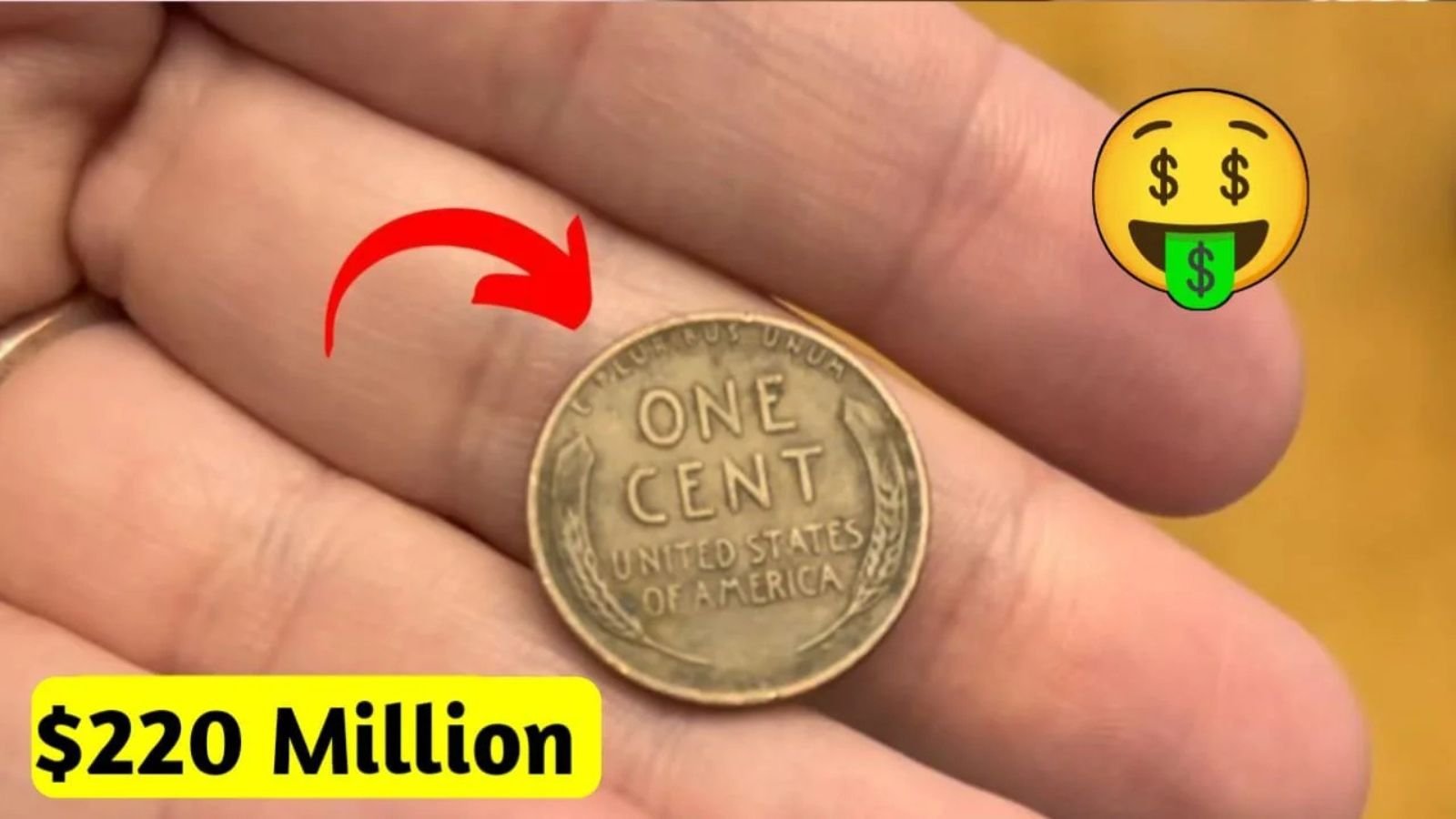Imagine checking your pocket change and discovering a coin so rare and valuable that it could completely transform your life. That’s the magical possibility surrounding the legendary Lincoln Wheat Penny, a coin that some numismatic experts and collectors now estimate could be worth an astonishing $120 million. Even more captivating is the fact that a few of these extraordinary coins might still be hidden in everyday circulation, just waiting for someone to stumble upon them.
In this detailed guide, we’ll dive into why the Lincoln Wheat Penny could command such an astronomical price, its rich historical background, how to identify one, and whether the chances of finding one today are real or just wishful thinking.
A Brief History of the Lincoln Wheat Penny
The Lincoln Wheat Penny—also lovingly called the “Wheat Cent”—was introduced in 1909 to commemorate the 100th birthday of President Abraham Lincoln. Prior to this coin, U.S. currency had traditionally featured allegorical figures like Lady Liberty. The Lincoln Wheat Penny broke tradition by being the first U.S. coin to depict a real historical figure.
The reverse side of the coin features two stylized stalks of wheat, intended to symbolize national prosperity and strength. This classic wheat design was minted continuously until 1958, after which the U.S. Mint replaced it with an image of the Lincoln Memorial.
While the majority of Lincoln Wheat Pennies are only worth their face value or slightly more, several rare variants, minting errors, and special editions have elevated a few examples into numismatic legends, commanding eye-watering prices at auctions.
Lincoln Wheat Penny Overview Table
| Category | Details |
|---|---|
| Coin Name | Lincoln Wheat Penny |
| First Year Minted | 1909 |
| Common Metal Composition | 95% Copper, 5% Zinc and Tin |
| Rare Variants | 1943 Copper Penny, 1909-S VDB, 1914-D |
| Highest Estimated Value | $120 Million (speculative special edition) |
| Still in Circulation? | Extremely rare, but theoretically possible |
| Designer | Victor David Brenner |
Why Would a Lincoln Wheat Penny Be Worth $120 Million
The typical Lincoln Wheat Penny you find might only be worth a few cents or a few dollars to collectors. So, what could possibly make one worth $120 million?
Several factors combine to make a particular Lincoln Wheat Penny extraordinarily valuable:
- Material Errors: In 1943, pennies were supposed to be made from steel coated with zinc to conserve copper for the war effort. However, a few were mistakenly struck on copper blanks. These 1943 copper pennies are among the rarest coins in U.S. history.
- Historical Significance: Some first-year issues, particularly those bearing the initials “VDB” (for designer Victor David Brenner) on the reverse, are extremely sought after.
- Condition and Grading: A Lincoln Wheat Penny graded as MS-68 (Mint State 68) or higher—meaning it is in near-perfect condition—can be exponentially more valuable.
- Collector Demand: As the supply of these rare coins is extremely limited, serious collectors are willing to pay incredible premiums, sometimes pushing values to speculative heights like $120 million.
In short, a Lincoln Wheat Penny that combines rarity, perfect condition, historical importance, and high demand could theoretically reach this stratospheric valuation.
Could a $120 Million Lincoln Wheat Penny Still Be in Circulation?
Although it might seem unbelievable, it is technically possible for a rare Lincoln Wheat Penny to still be hiding among everyday coins. Over the decades, coins have been lost, misplaced, tucked into furniture, or casually spent without knowledge of their true value.
A few extraordinary stories of people finding rare coins at banks, in vending machines, or hidden in inherited jars of change continue to fuel the dreams of modern-day treasure hunters. Though the odds are extremely slim, the idea that a $120 million Lincoln Wheat Penny could still be floating around keeps hope alive for hobbyists and collectors.
How to Identify a Rare Lincoln Wheat Penny
If you’re serious about increasing your chances of spotting a valuable Lincoln Wheat Penny, here are some expert tips on what to look for:
- Check the Date: Key dates include 1909 (especially the 1909-S VDB), 1914 (with a D mintmark), 1922 (missing D), and the famous 1943 (copper version).
- Inspect the Mintmark: Look for small letters under the date. “S” represents San Francisco, and “D” stands for Denver. Certain mintmarks dramatically increase a coin’s value.
- Magnet Test: In 1943, pennies were supposed to be made from steel. If a 1943 penny sticks to a magnet, it’s steel and common. If it doesn’t stick, you might have a rare copper version worth a fortune.
- Examine the Condition: The less wear and tear on the coin, the more valuable it could be. Uncirculated coins are particularly prized.
- Look for Errors: Doubled dies, off-center strikes, or missing elements can make a Lincoln Wheat Penny extremely valuable.
A good magnifying glass, patience, and a keen eye are essential tools for any aspiring coin hunter.
FAQs About the Lincoln Wheat Penny Worth $120 Million
Q1: Why is the 1943 Copper Lincoln Wheat Penny so special?
A1: During World War II, the U.S. Mint switched to steel pennies to save copper for war materials. A few copper planchets were mistakenly struck, resulting in extremely rare 1943 Copper Lincoln Wheat Pennies, each potentially worth millions.
Q2: How can I tell if my Lincoln Wheat Penny is valuable?
A2: Examine the year, mintmark, and overall condition. Coins from 1909 (especially 1909-S VDB), 1914-D, and 1943 (copper) are among the most valuable. Professional appraisal services can help verify authenticity.
Q3: Is it really possible to find a $120 million Lincoln Wheat Penny today?
A3: It’s unlikely, but not impossible. Many rare coins have been discovered by accident. Checking rolls of pennies from banks or inherited collections could yield surprising finds.
Q4: What should I do if I think I found a valuable Lincoln Wheat Penny?
A4: Avoid cleaning or altering the coin in any way. Bring it to a reputable coin dealer or send it for professional grading to authenticate and evaluate it properly.
Q5: Are there other Lincoln Wheat Pennies worth significant money?
A5: Absolutely. Beyond the 1943 Copper, coins like the 1909-S VDB, 1914-D, and 1922 No D varieties can fetch thousands to hundreds of thousands depending on their grade and rarity.
Final Thoughts
The story of the Lincoln Wheat Penny is more than just a tale about a piece of copper—it’s a story of history, human error, and the thrill of the unexpected. The idea that a humble penny could be worth $120 million is not just intriguing; it captures the imagination and passion of collectors worldwide.
Even though the odds of finding such a coin are slim, the sheer possibility makes it worth checking every Lincoln Wheat Penny you come across. Who knows? Your next handful of change could hold a piece of history—and maybe even a fortune.
Whether you’re a seasoned numismatist or just a curious soul fascinated by hidden treasures, the hunt for the next great Lincoln Wheat Penny discovery continues to inspire dreams of uncovering one of America’s most valuable collectibles.
Some Important Link
| Telegram Group | Click Here |
| WhatsApp Group | Click Here |
| Home Page | Click Here |













